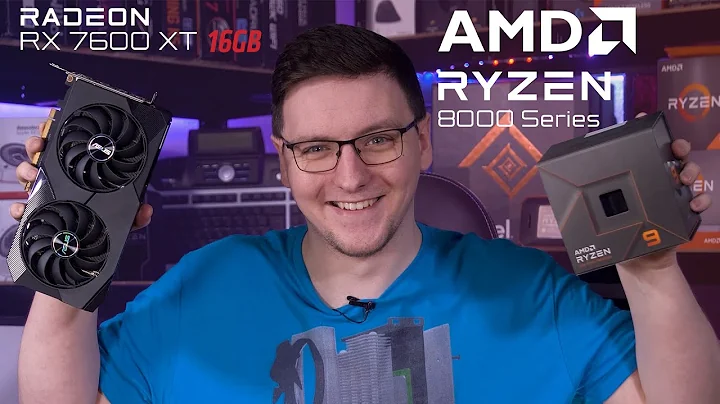Unleash the Full Potential of Your AMD Ryzen 5950X with Overclocking
Table of Contents:
- Introduction
- Understanding Overclocking
- The AMD Ryzen 5950X: A Powerful CPU
- Recommended Hardware for Overclocking
- Step-by-Step Guide to Overclocking
- 5.1 BIOS Settings for Overclocking
- 5.2 Adjusting Clock Ratio
- 5.3 PBO and Advanced PBO Limits
- 5.4 Curve Optimizer Settings
- 5.5 RAM Profile Settings
- Important Considerations for Overclocking Stability
- Monitoring Temperatures and Power Consumption
- Tips for Overclocking Success
- Pros and Cons of Overclocking
- Conclusion
🚀 How to Overclock an AMD Ryzen 5950X for Optimal Performance
If you're an avid PC enthusiast or gamer looking to push the boundaries of performance, overclocking your CPU can be a great way to squeeze out extra power from your system. In this guide, we'll explore the process of overclocking an AMD Ryzen 5950X processor, one of the most capable CPUs on the market. We'll discuss the necessary hardware, recommended settings, and step-by-step instructions to achieve a stable overclock. So, let's dive in and unleash the full potential of your Ryzen 5950X!
Introduction
Overclocking is the practice of increasing the operating frequency of a CPU beyond its stock speed to achieve faster processing and improved performance. By increasing the clock ratio and optimizing other settings, you can unleash the full power of your AMD Ryzen 5950X processor and enjoy smoother multitasking, faster gaming, and enhanced overall system responsiveness.
Understanding Overclocking
Before we delve into the nitty-gritty of overclocking the Ryzen 5950X, it's important to understand the basic concepts and terminology associated with this practice. Overclocking primarily revolves around adjusting the clock ratio, voltage, and other parameters to increase the CPU's processing speed. However, it's crucial to strike a balance between performance and stability to avoid system crashes or damage.
The AMD Ryzen 5950X: A Powerful CPU
The AMD Ryzen 5950X is a flagship CPU that boasts 16 cores, 32 Threads, and a base clock speed of 3.4 GHz. With advanced Zen 3 architecture and precision boost technology, it delivers exceptional performance and power efficiency. The Ryzen 5950X is designed to handle demanding tasks like gaming, content creation, and intensive workloads with ease. And with overclocking, you can unlock even more computing potential.
Recommended Hardware for Overclocking
To successfully overclock your Ryzen 5950X, it's important to have the right hardware in place. Here's a list of recommended components that can support a stable overclock and ensure optimal performance:
- Kingston Fury Beast RAM: 8 GB x 4 (32 GB total) for sufficient memory capacity.
- Orus Elite V2 Motherboard (Rev 1): A high-quality motherboard capable of supporting overclocking.
- RTX 360 TI GPU: A powerful graphics card that complements the CPU's performance.
- 850 W Power Supply: To handle the increased power demands of overclocking.
- Adequate PC cooling system: Invest in efficient cooling solutions to maintain lower temperatures during overclocking.
By ensuring you have the right hardware specifications, you can optimize your chances of achieving a stable and efficient overclock on your Ryzen 5950X.
Step-by-Step Guide to Overclocking
Now that we have a basic understanding of overclocking and the recommended hardware, let's dive into the step-by-step guide for overclocking your Ryzen 5950X. Following these instructions carefully will help you achieve a stable overclock and unlock the CPU's full potential.
5.1 BIOS Settings for Overclocking
To begin with, access the BIOS settings on your motherboard. Restart your computer and press the designated key (usually Del or F2) to enter the BIOS. Once inside, look for the following settings:
- Clock Ratio: Start by setting the clock ratio to 46 or 45.75. Adjust this value until you reach the maximum stable clock that your specific motherboard supports.
- PBO and Advanced PBO Limits: Set these settings to "Manual" to allow the motherboard to provide maximum power to the CPU. Avoid selecting other presets that may limit the overclocking potential.
- Curve Optimizer Settings: Experiment with different values to find the optimal settings for your setup. Start with values like 26 or 27 and gradually adjust them based on stability. These settings fine-tune the voltage and frequency curves to achieve better performance.
- RAM Profile Settings: Stick to the XMP profile settings provided by Kingston Fury Beast RAM for optimal performance. Avoid tweaking the advanced memory settings unless you have extensive knowledge of DDR tuning.
Adjusting these BIOS settings is crucial to achieving a stable and efficient overclock on your Ryzen 5950X. Make sure to save your changes before exiting the BIOS.
5.2 Adjusting Clock Ratio
The clock ratio determines the operating frequency of your CPU. By gradually increasing this value, you can push the Ryzen 5950X to higher speeds. Monitor your system's stability after each adjustment to find the maximum stable clock ratio that suits your specific setup.
5.3 PBO and Advanced PBO Limits
Power Boost Override (PBO) and Advanced PBO Limits settings allow your motherboard to deliver maximum power to the CPU. Keep these settings on "Manual" to ensure the CPU receives the necessary power supply during overclocking. Other presets may restrict the performance gains achievable through overclocking.
5.4 Curve Optimizer Settings
Curve Optimizer settings play a vital role in achieving stable overclocks on the Ryzen 5950X. Experiment with different values, starting around 26 or 27, and observe system stability. Gradually increase or decrease these values based on stability to find the best combination for your specific setup.
5.5 RAM Profile Settings
Stick to the XMP profile settings provided by Kingston Fury Beast RAM for optimal performance. Avoid adjusting advanced memory settings unless you possess in-depth knowledge of DDR tuning.
Important Considerations for Overclocking Stability
While overclocking your Ryzen 5950X, it's essential to consider several factors to maintain stability and avoid potential issues. Here are some important considerations:
-
Temperature Monitoring: Keep a close eye on your CPU temperatures during overclocking. Excessive heat can reduce stability and longevity. Ensure efficient cooling solutions are in place to maintain lower temperatures.
-
Power Consumption and Wattage: Overclocking can lead to increased power consumption by your CPU. Check your system's power supply and ensure it can handle the additional power demands.
-
Gradual Adjustments: Make changes to your overclock settings slowly and gradually. This allows you to pinpoint stability thresholds and avoid sudden crashes or system instabilities.
-
Benchmarking and Stress testing: Benchmark your system before and after overclocking to measure performance gains. Additionally, stress-test your CPU using reliable software to ensure stability under heavy workloads.
By taking these considerations into account, you can achieve a stable and efficient overclock on your Ryzen 5950X and enjoy the enhanced performance it brings.
Monitoring Temperatures and Power Consumption
When overclocking, it's crucial to monitor your CPU temperatures and power consumption to maintain stability and avoid overheating. Use software like AMD Ryzen Master to closely monitor temperatures, voltage, and clock speeds. Additionally, consider third-party software like HWMonitor or MSI Afterburner for real-time monitoring and fan control.
Tips for Overclocking Success
Here are some tips to enhance your overclocking experience and maximize your chances of success:
-
Start Conservative: Begin your overclocking journey with conservative settings and gradually increase them to find optimal stability.
-
Regular Backups: Save your BIOS profiles and track any changes you make. This allows you to revert to stable settings if needed.
-
Research and Experiment: Explore online forums, guides, and tutorials to learn from others' experiences and experiment with different overclocking techniques.
-
System Stability: Stress-test your system using reliable software like Prime95 or AIDA64 to ensure stability under heavy workloads. This will help you identify any instabilities and make necessary adjustments.
-
Keep an Eye on Temperatures: Maintain sufficient cooling and monitor CPU temperatures to prevent thermal throttling and potential damage to your components.
Pros and Cons of Overclocking
Pros:
- Increased CPU performance and improved system responsiveness.
- Enhanced gaming and multimedia experiences.
- Cost-effective alternative to purchasing a new CPU.
Cons:
- Increased power consumption and heat generation.
- Risk of instability and system crashes if not properly optimized.
- Possible reduction in CPU longevity and warranty.
Considering these pros and cons will help you make an informed decision regarding overclocking and whether it aligns with your specific requirements and preferences.
Conclusion
Overclocking the AMD Ryzen 5950X can provide you with a notable performance boost, but it requires careful tweaking and monitoring. By following the steps outlined in this guide and considering the important factors, you can unlock the full potential of your CPU and achieve stable overclocking results. Remember to maintain adequate cooling, perform regular stress tests, and make gradual adjustments to find the perfect balance between performance and stability. So, unleash the power of your Ryzen 5950X and take your computing experience to new heights!
 WHY YOU SHOULD CHOOSE TOOLIFY
WHY YOU SHOULD CHOOSE TOOLIFY
































